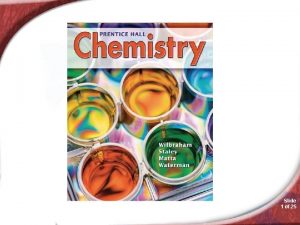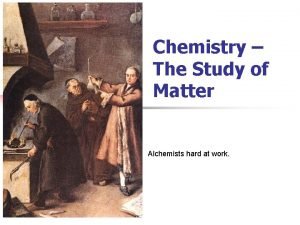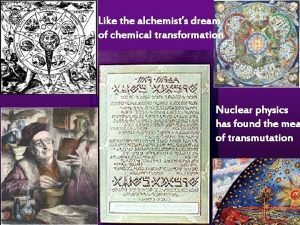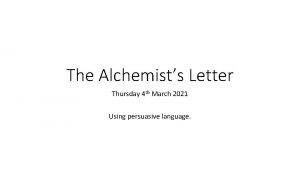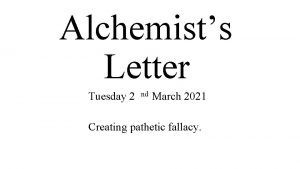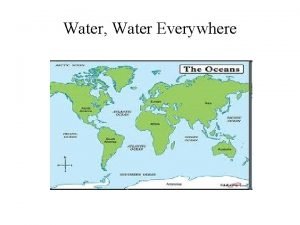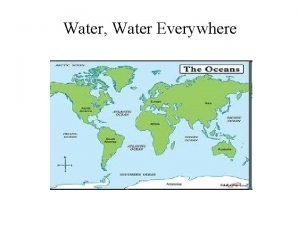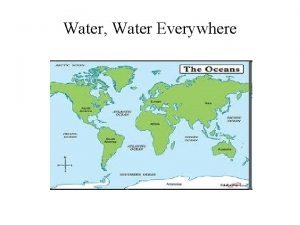WATER IN THE REPRESENTATION OF SOME ALCHEMISTS AND































- Slides: 31

WATER IN THE REPRESENTATION OF SOME ALCHEMISTS AND IN THE MIDDLE AGES OF GEORGIA KETEVAN KUPATADZE Water is Life 5 th Summer School of the Prof. Dr. Fuat Sezgin Research Foundation for the History of Science, Istanbul

The popular-science articles, are published with the my authorship in on-line magazine “The Teacher” and are targeted at wide range of readers, which includes any reader, having no connection with chemistry, and of course, teachers, as well as their students. The key purpose of these articles is to amuse the reader while engaging him/her into reading.

“In these latter days I attend courses in Turkish language. We have a teacher, named Esra, long haired and black eyed young woman. She does not know Georgian, but tries her best to learn it. The class is staffed with students; I am the eldest among them. However it does not make me uncomfortable and I am entirely engaged in the learning process. There are only two boys in the class, the rest are the girls and it’s not a surprise that there is much noise considering the number of girls assembled together. Esra Hoja (Teacher Esra) knows a couple of Georgian words, that’s why sometimes she shouts out with a warning tone: ”Gogolar (gogo – means a girl in Georgian), this is a mix of Georgian-Turkish. A girl is pronounced in Turkish as “kız”, in plural – “kızlar”, however “gogolar” is somehow different, affectionate and strict at the same time. You can ask her anything ten times, she won’t get tired of explaining with the same energy and enthusiasm. All was the same that day, when she was teaching us about clock, tirelessly drawing various versions of time on the board asking the question “Saat kach? (What time is it? )”; one of the girls joked in Georgian, our Hoja is like water. And as if someone had asked me I immediately translated to the teacher: “You are the woman like water”. At first she couldn’t understand, and then we explained that it meant an energetic person and being like water was considered to be a compliment in Georgia. Water is basis of life…

Ptolemy Goddess Tot

Priests thought that one metals could be changed into other…Like water which gave two other substance- Ice and Steam…

Jabir ibn Hayyan

Muhammad ibn Zakariya al-Razi

False Jabir

King of Spain - Philip II and Distilled water with Rose petals

Ramon Lull described water distillation method (XIII century); later on, this book was bought by King of Spain Philip II.

Paracelsus was an alchemist. This strange name was taken as a pseudonym, his real name was Philippus Aureolus Theophastus Bombastus von Hohenheim. He tried to compete with an Italian doctor, Avlus Kornelius Cels claiming to be superior to him. That’s why he called himself Paracelsus, i. e. superior to Celsus. Although being an alchemist, he used to practice in medicine as well. He was searching for a philosophers’ stone both for obtaining gold and for medical purposes. That time, two major issues were of concern: life prolongation and rejuvenation. In medicine, Paracelsus believed that blood was the most important thing calling it the main liquid. As for alchemy, he thought that Zink or table salt or distilled water would act as an accelerator facilitating sulfide’s (which was made of mercury and sulfur powder) transformation into gold.

Robert Boyle refused to use term “Alchemy” and established new term “chemistry”. The people who served this science (yes, it was already considered as a science because until then it was perceived as craft) Boyle called “chemists”. In 1661 he published the book “A Chemist-skeptic”, where he wrote that a chemist must doublecheck each theory and fact in the laboratory. Vakhtang VI also used the term – “Chemistry”.

King Vakhtang VI was engaged in active scientific, literary and translation activities. He made his name in Georgian history as a supporter of culture. The first typography was founded in Tbilisi in 1709. Vakhtang got priceless support from Antimoz Iverieli (clergyman from Rumania, Georgian by origin). Antimoz ordered his student- Michael Ishtvanovich to organize “typography houses”, which were built on the right bank of the river “Mtkvari”, between “Anchiskhati” and “Sioni” temples. The books were printed on paper imported from Europe and fully corresponded to world standards of those times.

The first typography in Tbilisi

The Book on mixing oils and making chemistry Vakhtang’s book “The Book on Mixing Oils and Making Chemistry” reached our times in a form of manuscript containing 72 pages. The manuscript consists of 279 paragraphs; the text contains several draughts of chemical tools. It should be mentioned that under the term “oils” Vakhtang meant liquids of different ingredients. Thus the name of this book implies a chemical transformation through mixing different liquids. Vakhtang’s book clearly reflects the level of chemistry development, correctly describing the technology of preparation of many compounds. At the same time, it represented the basis of inorganic chemistry in those times. This book demonstrates Vakhtang’s creative potential, high scientific culture and his wide education.

The Book on mixing oils and making chemistry



Do you know? The name of Tbilisi is connected with water. According to the legend, the ancient capital of Mtskheta surrounded by forests was the place, where the king Vakhtang Gorsalali was hunting. One day during the hunting the king’s falcon was chasing a pheasant when the falcon suddenly vanished. After a long search, the birds were found scalded in a hot spring. King Vakhtang gave the order to build the city in this place and to call it Tbilisi (translates as “warm”).

You can hear another story about king’s hunting. It describes how the king wounded a deer and the animal plunged into the sulfur spring whereupon it instantly healed and disappeared. It impressed the king and he decided to build a city on the site. These beautiful legends are far from reality. In fact, the city was built long before the reign of Gorsalali. The first mention about it was in the IV-III centuries BC. Anyhow the hot mineral springs contributed the development of the city and the construction of sulfur baths. The number of Sulfur springs flowing from Mount Tabor is huge. For example, in the late 19 th century, it was counted about thirty-one. Their temperature is quite comfortable (about 37 Celsius degree). That’s why it’s the favorite place for bathing among residents. Gradually springs turned into the modern baths. They were built by Georgians and Turks as well as the Persians.

Sulfur-alkaline springs occupies the central part of Tbilisi where was formed a bath area (Abanotubani), extending along the street Grishashvili. In ancient times the most influential people tried to build in the area a bathhouse named in their honor. Changing an ownership meant changing the name of the bath. Extant baths were built in the XVII-XIX centuries.

Tbilisi baths’ feature is that they receive water from underground sources which contains a lot of sulfur and has warm temperatures (by the way, these baths can be found only in several countries – Italy (Tivoli region) and England). The geothermal water of sulfur springs has a unique healing composition. It contains bromine, iodine and other useful minerals. Sulfuric water has a smell of rotten eggs (it quickly disappears), but it’s very soft and pleasant.

The most famous Baths in Tbilisi Orbeliani Baths

Royal Bath House

Sulfur Baths

Bakhmaro Baths

Bathhouse No. 5

This area is unique that is considered to be one of the main attractions of Tbilisi. Georgian poet Joseph Grishashvili expressed this concept as: “if you visit Tbilisi with no visiting of sulfur baths, it is equivalent of traveling to Paris without visiting of Eiffel Tower”. Probably that’s why the street around the baths is named after the poet.

Archeological expedition has unearthed extremely old Roman baths, systems of water-supply and ruins of other buildings at the territory of a fortress in Gonio-Apsarosi , located in the Adjara region in southwestern part of Georgia. The baths date back to 1 st century A. D. , and according to archeologists’ estimates, were built in its second half, during the rule of Emperor Vespasian. The walls of the Apsarus fort with a solid foundation, four gates and twenty-two towers were built. At the southern gate, in front of tower 20, a watch station of roads guards, of the so-called beneficiaries, was set up. Three water-mains of powerful digit were laid on. The headwork has survived to the present day. Cleaning of the fort, water supply and sanitary service were done at a high level.

“I Will Die without You” “No, I am not joking, I will die without it. First the sorrow will encompass me; I will frequently get tired and will be unable to get asleep. I will slowly become pale, my breathing will become rapid and the muscles will weaken. Blood pressure will get lower and I might get cardiac arrhythmia. My immune system will weaken and if I don’t take care of myself on time, perhaps you guess how I will end up. However, it might happen to you as well. No, I’m not kidding, the lack of it will kill you too”. “It has been known from ancient times. Egyptian priests, the followers of chemeya would compare it to life. And they were right -the lack of it will really destroy all of us. ” Take care of the water

Sizi çok teşekkur ederım Thank you for your attention დიდი მადლობა
 Alchemists developed processes for separating
Alchemists developed processes for separating Water and water and water water
Water and water and water water Contact and noncontact forces
Contact and noncontact forces Some trust in chariots and some in horses song
Some trust in chariots and some in horses song Sometimes you win some sometimes you lose some
Sometimes you win some sometimes you lose some God when you choose to leave mountains unmovable
God when you choose to leave mountains unmovable Ice-cream countable or uncountable
Ice-cream countable or uncountable Fire and ice diamante poem
Fire and ice diamante poem Some say the world will end in fire some say in ice
Some say the world will end in fire some say in ice Conjunction words definition
Conjunction words definition Bart has decided to buy some water balloons
Bart has decided to buy some water balloons Homer has decided to buy a trampoline
Homer has decided to buy a trampoline Hình ảnh bộ gõ cơ thể búng tay
Hình ảnh bộ gõ cơ thể búng tay Slidetodoc
Slidetodoc Bổ thể
Bổ thể Tỉ lệ cơ thể trẻ em
Tỉ lệ cơ thể trẻ em Voi kéo gỗ như thế nào
Voi kéo gỗ như thế nào Chụp phim tư thế worms-breton
Chụp phim tư thế worms-breton Chúa yêu trần thế
Chúa yêu trần thế Các môn thể thao bắt đầu bằng tiếng nhảy
Các môn thể thao bắt đầu bằng tiếng nhảy Thế nào là hệ số cao nhất
Thế nào là hệ số cao nhất Các châu lục và đại dương trên thế giới
Các châu lục và đại dương trên thế giới Công thức tính thế năng
Công thức tính thế năng Trời xanh đây là của chúng ta thể thơ
Trời xanh đây là của chúng ta thể thơ Mật thư anh em như thể tay chân
Mật thư anh em như thể tay chân Làm thế nào để 102-1=99
Làm thế nào để 102-1=99 độ dài liên kết
độ dài liên kết Các châu lục và đại dương trên thế giới
Các châu lục và đại dương trên thế giới Thể thơ truyền thống
Thể thơ truyền thống Quá trình desamine hóa có thể tạo ra
Quá trình desamine hóa có thể tạo ra Một số thể thơ truyền thống
Một số thể thơ truyền thống Cái miệng nó xinh thế chỉ nói điều hay thôi
Cái miệng nó xinh thế chỉ nói điều hay thôi
